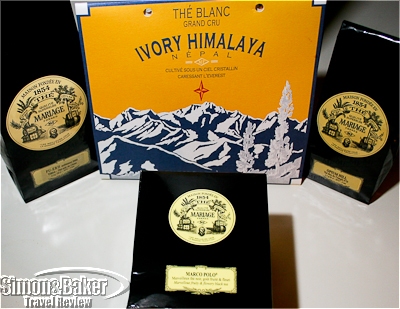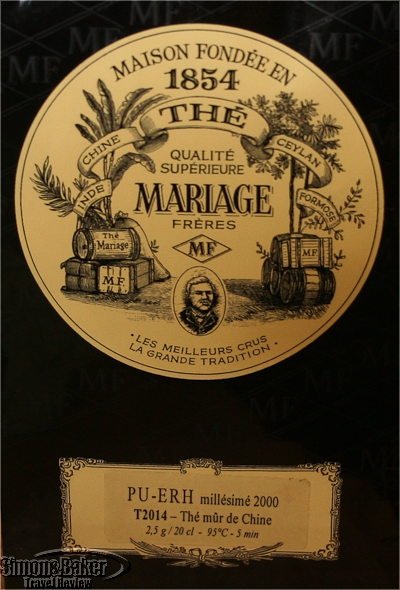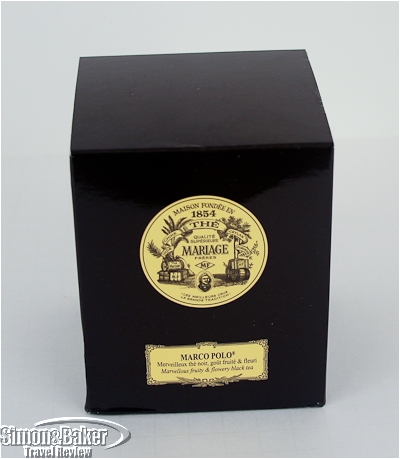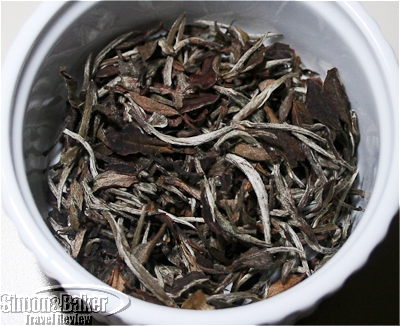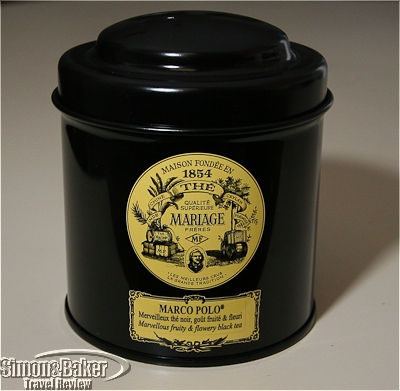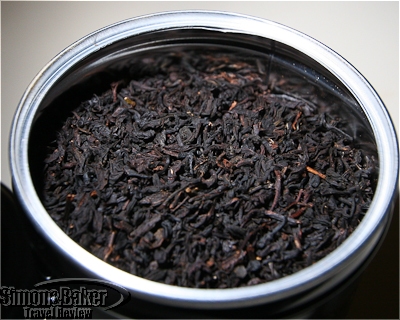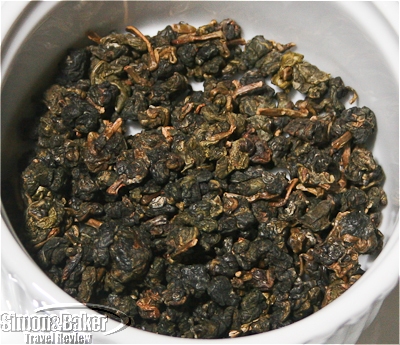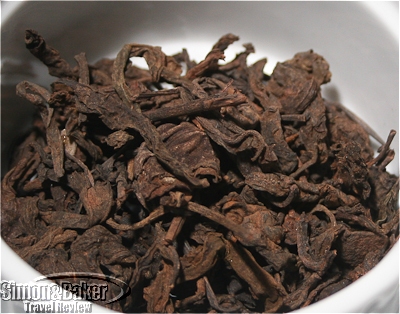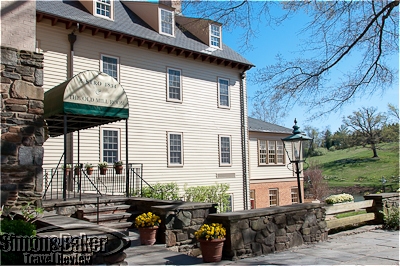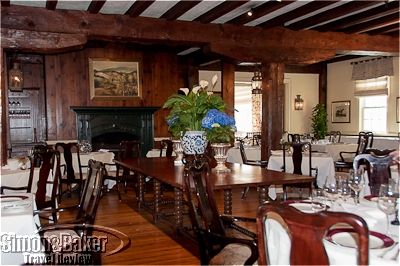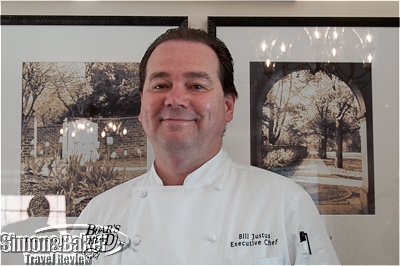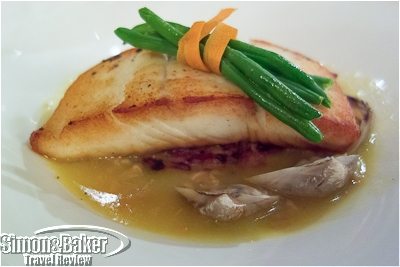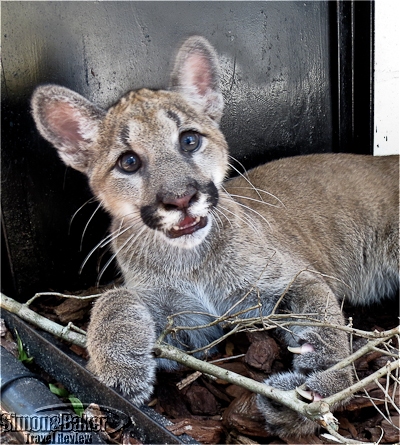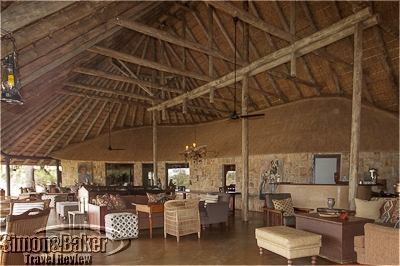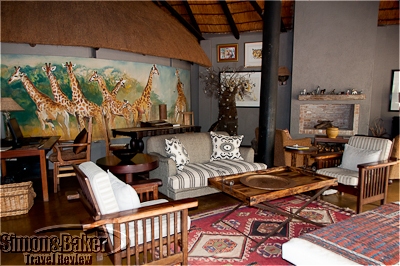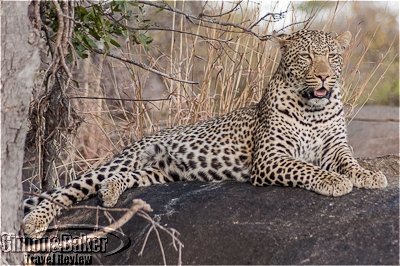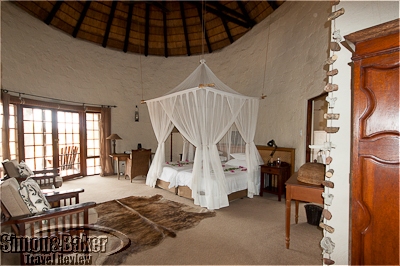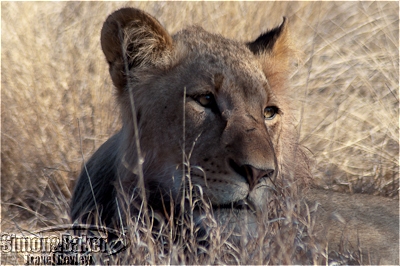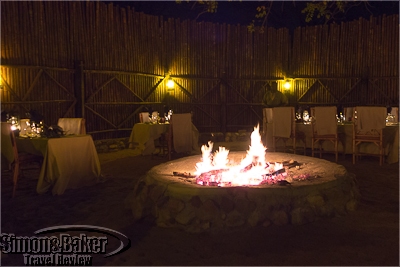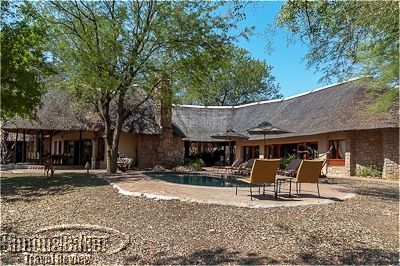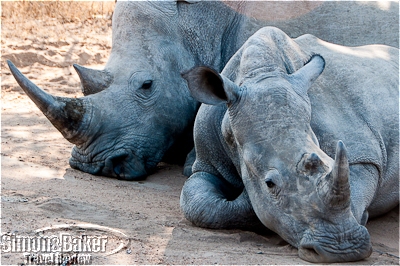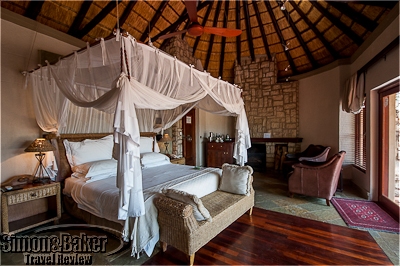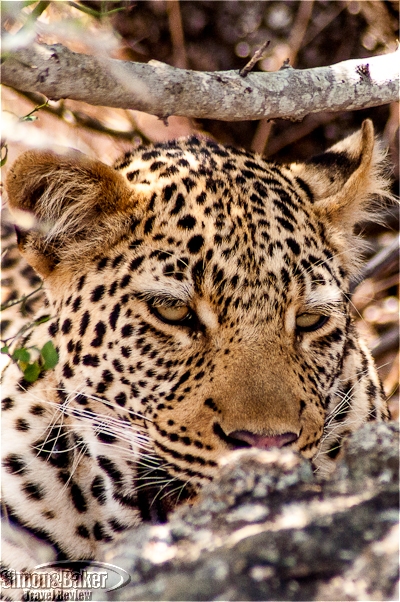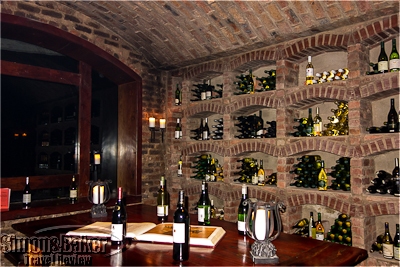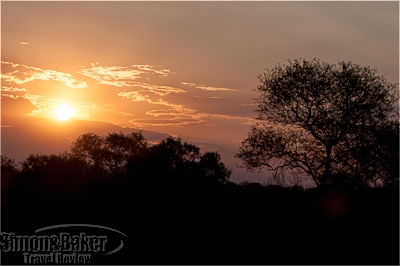Luxury Travel Review

Gourmet teas a reminder of Paris at home
By Elena del Valle
Photos by Gary Cox
Our selection of Mariage Freres teas
Over the years we have sampled so many teas we’ve lost count. From plantations in India to gourmet tea shops in Paris, France and many places in between, tea has accompanied many special and memorable occasions.
Recently, we decided to sample a variety of teas over a few days. The idea was to dedicate our clean palates to tasting a single tea or two at most per sitting. The time and attention were meant to allow us an opportunity to explore the tea leaves and their color, tea fragrance and taste, and lastly the finish if there was one.
A closeup of the label showing brewing instructions
To compare apples to apples as it were all the teas we sampled were from the same shop, Mariage Freres Marais in Paris, France (Mariage Freres Marais, 30 rue du Bourg-Tibourg,75004 Paris, France, www.mariagefreres.com, info@mariagefreres.com,+33 1 42 72 28 11). Some we brought home with us and others arrived by post. The shipping caused some unpleasantness with the delivery company who tacked our small order with customs processing fees even though there was no evidence that customs officials viewed our package, and without ever obtaining our approval in advance.
The Marco Polo tea came in a tin inside a box
We sampled the following loose teas: Ivory Himalaya The Blanc Grand Cru, Marco Polo Mervelleux the noir gout fruite et fleury (marvelous fruity and flowery black tea), Opium Hill The Bleu du Triangle d’Or (blue tea from the Golden Triangle), and PU-ERH millesime 2000 (vintage 2000) The mur de Chine (ripe tea from China). We also tried Sables au The Marco Polo (Marco Polo flavor sable cookies).
The Marco Polo Mariage Sables
The label on each bag, box or container provided instructions including the quantity of tea leaves per cup, the water temperature and the amount of brewing time. We followed the directions preparing the tea with bottled water and placing the tea leaves in individual cotton tea sleeves. We served the tea in a clear glass cup that allowed us to see the color of each tea.
The Ivory Himalaya tea
The Ivory Himalaya white tea came in a plastic bag within a square carton which was sealed in an airtight wrapper. The tea weighed 20 grams. There was no visible expiration date on the package. The recommended serving was five grams of tea per cup brewed (one quarter of the package) for five minutes at 80 Celsius (below boiling). Sourced at a Himalayan plantation in limited quantities it was the priciest of the teas we sampled in that series.
The Marco Polo tea in the tin
A closeup of the Marco Polo tea
The Marco Polo tea came in a pretty black tin containing 100 grams. The expiration date was January 2017. The recommended serving size was two and one half grams of tea per cup brewed for four minutes at 95 Celsius (below boiling). The tea leaves in the container had a distinctive fruity scent which was more pronounced in the brewed beverage. The tea was an appetizing rich medium brown which tasted of mild black tea with a slightly sweet fruit and flower taste. There was no finish of note. We tasted the Marco Polo cookies, made with wheat flour, sugar, concentrated butter, eggs and Mariage Freres Tea, at the same time as the eponymous tea. The buttery, crunchy and sweet cookies came in four plastic wrapped packets of five cookies each. The expiration date was August 2014.
The Marco Polo cookies
The Opium Hill kernels came in a foil 100 gram bag and had an expiration date of January 2016. The recommended serving size was four and one half grams of tea per cup brewed for two minutes at 90 Celsius. Per the salesman’s instructions we infused it three times. He indicated up to seven infusions were possible from a single serving. The tea was pale green with a subtle green tea flavor. We couldn’t be sure if the color grew paler with each infusion. The scent was mild and made us think of green tea. The first infusion had a well defined taste. The flavor became less noticeable and more nuanced with each infusion while the finish became longer lasting and more pronounced. The idea that the third infusion had no theine held particular appeal for us. The third infusion, especially the finish, was a favorite.
The Opium Hill Blue Tea
The PU-ERH came in a foil 100 gram bag which listed no expiration date. The recommended serving size was two and one half grams of tea per cup brewed for five minutes at 95 Celsius. The color was pale. While the scent of the leaves and the brewed tea were the strongest of the teas we sampled in that series the flavor was unexpectedly light. Words that came to mind were musty, smokey and dark all within a palatable range.
A closeup of the PU-ERH millesime 2000
The blue tea, reminiscent of green tea, was a favorite for regular consumption. Given its delicate flavor the Ivory Himalaya would be appropriate for special occasions or to share with friends. The nuances of the tea taste compared to the high cost were difficult to quantify, especially given the many fine tea choices available. On the other hand, the lingering finish on the palate was unequaled in that series and worth seeking out. To read about our tea and gourmet experience at the Mariage Freres Marais Paris tea shop, see Superb gourmet lunch at Paris tea salon
History meets classic cuisine with Virginia twist in Charlottesville
Article and photos by Josette King
The Old Mill Room restaurant was located in the historic part of the property
The Old Mill Room is a restaurant with a distinguished past and a cuisine grounded in the present. Located in the historical core of the Boar’s Head in Charlottesville, Virginia, it was built from a valued piece of local history, the repurposed timber from an abandoned 1834 gristmill famous for having survived the Civil War and gone on to operate a whole six decades after it. Moved piece by pieced from is original site on the banks of the Hardware River, it was integrated in the construction of an inn’s main building in the early 1960’s.
The shaded central lawn of The Boar’s Head evoked of a town common of old
The décor of the restaurant had been designed to showcase those striking architectural details while creating a refined environment that evoked timeless southern grace. It was an ideal setting for the elegant classic cuisine with a Virginia flair and international contemporary touches dished out by Bill Justus, executive chef, and his team.
At the Old Mill Room the building was not the only custodian of a proud history. When Chef Justus joined the Boar’s Head as executive chef in 2010, he took over a restaurant with the singular distinction of being the longest holder of a AAA Four Diamonds designation in the Commonwealth of Virginia.
The historic Old Mill Room was built from the timber of an abandoned 1834 gristmill
Justus maintained the award winning culinary excellence while bringing to the menu the lighter dishes, farm to table freshness of local ingredients and imaginative flavor and texture pairings I appreciated. At the time of my visit, the Old Mill Room had been awarded once again its Four Diamonds, for the 27 consecutive time.
Executive Chef Bill Justus
From the amuse bouche of chilled watermelon with goat cheese mousse to the perfectly caramelized creme brulee, my meal was a shining example of the creativity that went on in the kitchen. My appetizer skillfully balanced the sweet tenderness of exquisitely seared scallops with a light crust of smoky ancho chili pepper and bitter cocoa. As for the sunburst trout filets of my main course, they were dusted with blue cornmeal and served with a colorful accompaniment of tiny black Peruvian potatoes and Atlantic lobster succotash, and a discrete dash of Pernod in the light lobster sauce. It was interesting and delicious.
Pan seared halibut with steamed clams in a light saffron sauce
It stands to reason that my local friends regard the Old Mill Room as one of the greater Charlottesville area de rigueur places to celebrate special occasions. I will plan to return myself, the next time my travels take me back to Central Virginia.
Panther cub, Florida wildlife draw to state park
Article and photos by Elena del Valle

Homosassa Springs Wildlife Park
Yuma, the Florida panther cub (click to enlarge)
Florida’s state animal, the panther, is one the most endangered mammals on Earth. With population estimates at less than 200 they are near impossible to observe in the wild. According to the U.S. Fish and Wildlife Service, there are between 100 and 160 adult panthers in the wild in South Florida. These animals once ranged throughout most of the southeastern United States. By the late 1800s the Florida panther had been run off from much of its historical range because its habitat had been destroyed or by human attacks.
They are beautiful animals. When I found out I might be able to see a four month old cub in a wildlife sanctuary I jumped at the opportunity. The drive, several hours long, took me across the state from the southeastern corner of the Florida peninsula northwest to the Ellie Schiller Homosassa Springs Wildlife State Park (4150 S. Suncoast Boulevard, Homosassa, Florida 34446, www.floridastateparks.org/homosassa, +1 352 628-5343, Susan.Strawbridge@dep.state.fl.us) in Citrus County where the cub found a permanent home. I stayed at the 68-room Hampton Inn Crystal River (1103 N Suncoast Boulevard, Crystal River Florida, 34429, +1 352-564-6464, www.crystalriver.hamptoninn.com, Chris@mymaverick.net) a clean, newly built (completed in 2013) property conveniently situated a few miles north of the park.
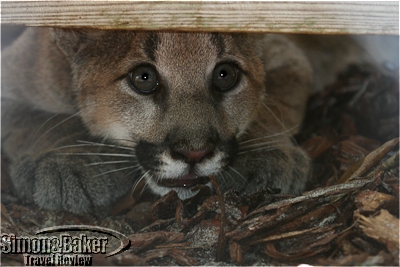
The cub was playful and in constant motion
When he was one week old he was rescued by wildlife personnel after his mother abandoned him or met an unknown fate herself. Having been brought up by humans, he would not be able to survive in the wild. Instead, his home will be a 80 foot by 120 foot special enclosure at the state park which was still under construction when I visited the area.
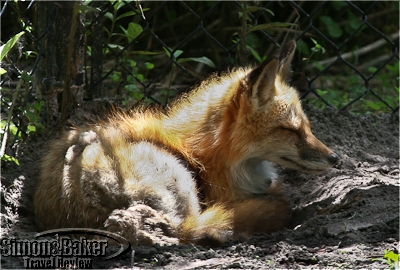
This cute red fox was sleeping in the partial shade
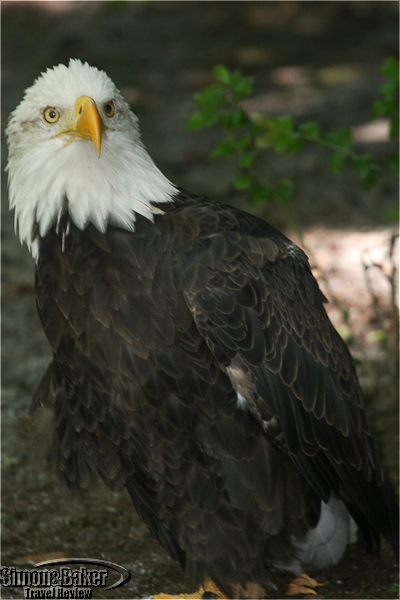
One of several eagle residents
Yuma, meaning son of the chief in a blend of Native American languages, was playful, energetic and mesmerizing. I could have watched him all day, racing across one side of his temporary fenced in enclosure to the other, climbing, chewing on his toys, eating, leaping against the fence or sitting in the shade.

A pink flamingo
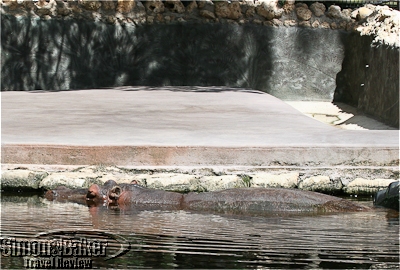
In typical hippo fashion, Lu spends his day submerged and barely visible
With 300,000 annual visitors, the 210 acre Ellie Schiller Homosassa Springs Wildlife State Park is said to be the most visited state park in Florida. At the time I was there, it was home to fifty Florida animals such as black bears, bobcats, river otters, red wolves, Key deer, American alligators, gray fox, red fox, roseate spoonbills, eagles, herons, egrets and whooping cranes. There were several resident West Indian manatees which could at times be seen from a floating observatory that sits in the middle of Homosassa Springs. Perhaps the most famous resident of the park was Lu, a hippopotamus who was made a Florida citizen by a governor’s decree so that he could live out his days in the park when it was converted to an exclusive home of native wildlife.
Outstanding game viewing, responsible tourism practices, superlative experience at Motswari in Timbavati Nature Reserve
Article and photos by Josette King
The lounge was an eclectic mix of safari antiques, rustic furniture, local crafts
On my first visit to Southern Africa a decade or so ago, my very first guide predicted: “Once the red dirt of Africa gets into you hiking boots, you will never get it out.” Now, a couple of pairs of boots later, I understand what he meant. But, the power of iron saturated clay dust notwithstanding, what keeps me going back is that every so often on those safaris, I come across an exceptional guide who can make the wonder of the natural world come alive, someone like Hearold Mgiba, the guide I had the good fortune to meet on my recent visit to Motswari Private Game Reserve in South Africa.
The library and art gallery
Wedged in the northern corner of the famed 54,000 hectare (209 square mile) Timbavati Nature Reserve, one of the oldest and most pristine in South Africa, and with an open boundary with Kruger National Park, Motswari is reputed for its density of game. The Big Five (buffalo, elephant, leopard, lion and rhino) roam there. So I expect it would have been relatively easy for Hearold and Difference Hlophe, an excellent tracker, to ensure that I enjoyed what is considered the gold standard of African safaris: repeated Big Five sightings. And I did enjoy those, daily. But one hour into our first drive, I was beyond counting. We were driving into thicket so dense I didn’t imagine we could possibly get through it, much less see anything of note, tracking a leopard. Hearold and Difference knew their big cats and found the one they were searching for in the end, concealed in the rocks near a water hole. We followed it around its territory to the tree where it had stashed its recent impala kill.
A large male leopard surveys its domain
The next morning found us among leopards again as we watched an old male go in the blink of an eye from snoozing in the high grass to snarling menacingly from the top of a 20 meter (65 foot) tree at his nonplussed pursuer. In fact, in my three days at Motswari, I was able to observe at length and at close range more leopards than I had seen in all of my previous visits to Africa. And there were also lions: a fascinating interaction between two males feeding on the carcass of a buffalo calf, and a whole pride going about its daily business; and elephants, a large breeding herd of them on the move with nursing calves; and mud encrusted rhinos crashing their way out of a water hole; and cheetahs on the prowl, and a whole supporting cast of mammals and birds. And in most instances, these weren’t mere sightings but unique opportunities to enjoy an authentic bush experience.
My Bungalow was decorated in relaxing neutral tones
The lodge itself reinforced this feeling. With its neat guest room rondavels scattered in a mature grove along the river, the homey atmosphere of its public areas and its large boma for dinners around the flames of a central fire pit, Motswari had the feel of a family country estate. I especially enjoyed the relaxed simplicity of my airy rondavel, with the creature comforts and modern amenities I could wish for in the bush, such as a king size bed under a romantic white netting canopy, mission style armchairs with thick canvas cushions, a good writing desk and chair, a sunny modern bathroom, ceiling fan and air conditioning, and round the clock electricity with plenty of outlets to recharge my electronic equipment. Returning there after long, exciting game drives, I appreciated all the more that Motswari had eschewed the edgy chic and flamboyance that has become a trend in recent years and sometimes gives me a sense of disconnection from the wilderness.
There was a large resident pride in Motswari
Beyond creating a welcoming haven for its guests, I also valued Motswari for its ongoing commitment to nature conservation and responsible tourism, which has been the guiding principle of the Geiger Family since it acquired the property three decades ago. From the onset, the original owner, the late Paul Geiger, focused on wildlife conservation and environmental management, and on creating employment and growth opportunities for the local communities; thus practicing the key tenets of responsible tourism and sustainable development long before they were articulated by the international community.
A rhino was caked with mud after a visit to a water hole
In recent years, Motswari has been repeatedly recognized for its achievements in that arena, such as its ongoing accreditation by the prominent Fair Trade in Tourism, South Africa (FTTSA), a distinction the property first earned in 2008. In early 2013, Motswari also achieved Gold Class status on the Heritage Environmental Certification Program (based on internationally recognized sustainability and responsible business initiatives), making it the only environmentally certified lodge in Timbavati. I especially appreciated the property’s concern for its people. Over and again its policies set the stage for responsible tourism. There appeared to be no gender discrimination for any position. Individuality and initiative were encouraged and acknowledged with a wide range of recognitions from Employee of the Year to Most Valuable and Most Popular and Best Dressed (staff members were given the opportunity to design their own uniform).
Dinner was served in the boma
Because the property was located deep into the reserve, it was necessary for all staff members to live on site. The family friendly staff village included accommodations for visiting spouses. I enjoyed hearing about some of the success stories, such as that of Godfrey Mathebula who grew up on the property and started out in the maintenance workshop. When he became interested in tracking and guiding, Paul Geiger sponsored his education. Mathebula went from guide to head guide to assistant general manager. In 2012, he was nominated for South Africa Guide of the Year.
Motswari also reached out to the community at large. As well as supporting local (Hoespruit) organizations with donations, the property had designated staff members to work with these organizations on issues of basic healthcare, nutrition, HIV education and testing. I left with the impression that the property’s responsible tourism ethos created a tight knit community among the management and staff of Mostwari, and an all around friendly atmosphere that directly influenced the exceptional quality of my bush experience there.
What I liked about the Playaway all in one audiobook player
Article and photos by Gary Cox

The Playaway audiobook player (headphone jack along the bottom)
For many years, I have enjoyed listening to audiobooks. They fill the hours on long flights and often go with me while I’m doing routine chores and running errands. Audiobooks bring the text to life, with a good narrator strengthening the performance with different voices and proper emotional emphasis. It is easy to imagine the appeal of radio programs before television made visual entertainment the dominant force that it is today.
The process of downloading audiobooks involves multiple steps and the menus in my favorite player require extensive navigation to play a book. I have gotten used to it because I enjoy the medium, but I suspect that less technologically inclined people might not survive the effort.

The case and the player
I recently had the chance to try out the Playaway all in one audiobook player assembled in Ohio. It is an audiobook with a dedicated player bundled in a convenient plastic case. The case and player I received mimic a book cover, with a typical summary description of the story and credits. The case held the two ounce player and a single AAA battery (for longer term storage to avoid any chance of corroding the player). The player fits comfortably in my shirt pocket. The top of the player is heavier with the battery and slides into a pocket naturally. The standard headphone jack in the bottom (headphones not included) of the player faces the top of the pocket so that my headphones remains untangled.

The case holds the player and the battery
The player controls are standard, allowing me to navigate the contents of the single audiobook, with a back lit LCD display clearly showing the current position and messages during startup and shutdown. The layout of the flexible rubber buttons allows space for large fingers. The buttons respond to comfortable pressure, and the power button toggles a lock to prevent accidental pushes when in a pocket. The player features a speed button, allowing five different playback speeds.

The player displays the book cover
The main target audience for these audio books is lending libraries and facilities where multiple people can borrow the books to listen and return them when they are finished. There are thousands of titles offered on the site in various genres. According to the seller, the audio players are well suited for children, seniors and visually impaired individuals, as well as avid readers like me. My personal experience of using the Playaway audiobook has been positive.

The battery compartment is on the top of the player
In our house, we read many paperback books. Once finished, they go to a local charity or recycling bin depending on their condition. We keep several bookshelves of fiction too good to part with after the first reading. These consist of hard to get, no longer in print, or favorite authors we expect to take out again. It is easy to imagine using the Playaway books to build a library of audiobook favorites. In summary, the Playaway all in one audiobook offered me the convenience and simplicity of function in an attractive portable package. Findaway World, 31999 Aurora Road Solon, Ohio 44139, 1-877-893-0808, www.my.playaway.com, jbelardo@findawayworld.com
A rich South African safari experience at Thornybush Game Reserve boutique property
Article and photos by Josette King
The lodge and swimming pool
In the local Shangaan language, so I had heard, shumbalala means “the place where lions sleep.” And I was headed to Shumbalala, the intimate luxury lodge located in the heart of South Africa’s Thornybush Game Reserve, known for the density of its resident population of lions as well as other Big Fives species (buffalo, elephant, leopard and rhino). My expectations were high. Even as I transferred from the car that had brought me from nearby Hoedspruit Eastgate Airport to the Shumbalala open game viewing vehicle that met me at the gate (no private vehicles were allowed in Thornybush), I held my camera at the ready for lions.
Rhinos enjoyed a nap in the shade
Moments later, I had forgotten about them. I was staring slack jawed at a scene I had never before experienced in my repeated visits to Africa: a tangle of rhinos, tightly huddled together in search of relief from the searing midday heat under the meager shade of a roadside tree.
Throughout my stay, while I enjoyed plenty of big cat sightings, leopards and cheetahs as well as the eponymous lions, rhinos commanded the limelight. Whether in a breeding herd with young calves grazing in the sunset or in groups of mature males crashing determinedly through the bush, they were an awesome sight. And like the other big game I encountered around Thornybush, these often shy behemoths were sufficiently habituated to humans that they all but ignored our presence, allowing for an outstanding opportunity to observe and photograph them at length and at close range.
The sleeping area of Suite Number Three
At Shumbalala, game viewing was only the beginning of an exceptional safari experience in the grand South African tradition. Nestled in a shaded grove at the edge of a seasonal river, reduced to a busy water hole when I visited at the height of the dry season, the property was a secluded oasis of classic elegance in the midst of a great swath of pristine open bush. With its spacious main lodge and only five guestrooms, each a cozy free standing thatched structure, Shumbalala offered the opulent comfort of an African country manor of a bygone era and the personalized hospitality to which only an intimate boutique property can aspire.
We came across this leopard concealed in the underbrush
The meals as well as the early morning and late afternoon game drives punctuated the days with enjoyable convivial interludes. From a hearty late morning brunch, bountiful mid afternoon high tea and elegant five course evening dinner, and some snack opportunities in between, every dish was beautifully prepared and served; and the cuisine was an artful blend of local specialties and international classics.
The wine cellar
Another notable feature of Shumbalala was its state of the art wine cellar. It was a lovely pre-dinner treat to visit the romantic vaulted space and select from a number of excellent South African labels a bottle to enhance my evening’s menu.
With its superb accommodations and hospitality, excellent game viewing opportunities and easy road and air access from the international hub of Johannesburg, Shumbalala was an ideal destination for travelers who preferred an easy one stop luxury safari experience. I personally found it an outstanding stop in my regional itinerary of game reserves and national parks.
A Shumbalala sunset

